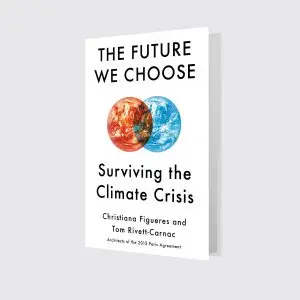A new book called The Future We Choose lays out two scenarios for the future: what 2050 looks like if the world continues on the current trajectory of emissions—killer heat waves, food riots, filthy air, the disappearance of coral reefs—and what it might look like if we make the radical changes necessary to limit warming to 1.5 degrees Celsius, staving off the worst impacts of climate change. Then it explains what has to happen to succeed on the second path, including how anyone who is overwhelmed by the challenge can take action today, this month, and over the next decade. (You can read an excerpt from the book here.)

The first step: Choose optimism, even if you’re fighting with despair over the state of disasters that are already unfolding and predictions for the near future, like the looming extinction of 1 million species. “We think that optimism is a decision,” Figueres says. “It’s a choice that we make . . . It’s basically an open attitude that is not a guarantee of success, but that actually opens the possibility towards success. We also understand that the opposite, fatalism, is a guarantee of failure.”
Next, recognize that you have power on a personal level to begin to change larger systems, whether that’s to influence corporations or policy. “The whole global economy is nothing other than the collectivity of individuals,” she says. “We tend to forget that organizations are nothing other than individuals organized around one business model. We think of a huge chasm between the systemic and the individual.”
But, of course, when enough people change, the economy responds. “If a critical mass of individuals change, for example, their diet—and many are, towards plant-based diets—what that actually does is send a very strong market signal to companies that are already answering that demand.” Some of the world’s largest meat companies are now heavily invested in making plant-based meat; if the entire world decided to become vegan, one study estimated that food-related emissions would drop by 70%.
The book presents a clear action plan for readers, beginning with a commitment to make climate your number-one political priority for the next decade, writing to elected officials today to inform them of that choice, and becoming active in local climate groups. (This shift is already happening; Democrats, for example, now rank climate as a key priority. The majority of Americans—6 in 10—now say that they are “alarmed” or “concerned” about climate change, triple the percentage of five years ago.) To reach a tipping point for political change, only a relatively small number of people need to be vocal.
“If you look at historical movements, when they reach about 3.5% of the population being actively engaged in some form of civil disobedience, protest, et cetera, then they tend to win,” says Rivett-Carnac. “They tend to get to a situation where the tipping point actually gets brought forward, and it tends to enter the mainstream zeitgeist and lead to political change and business change.” One recent example was New Zealand, where around 3.5% of the population participated in climate strikes last fall, and the government then said it would cut emissions to net-zero by 2050. Already, amazingly, 49% of the global GDP is now covered by a target to reach net-zero by 2050.
The book also suggests making a commitment to cut your own carbon footprint by more than half over the next decade—even if you don’t yet know how you’ll accomplish that. One immediate step: Pick at least one day each week that you’ll go meat-free. Other potential changes range from the seemingly mundane, such as making your home more efficient so you’re not wasting energy (and money) in heating and cooling, to changing how you commute, rethinking your attachment to consumerism, or choosing to attend business meetings by videoconference rather than flying. Some other changes may be larger, and the book suggests thinking creatively about how you can have the most impact.
“I think we humans tend to overestimate what we can do in a year and underestimate what we can do in 10 years,” he says. “That’s part of the reason why we wanted to frame this in 10 years.” That might involve bigger investments—like whether you buy an electric car or a new geothermal heating system—or a decision to move to different job with a lower footprint (or where you can play a bigger role in helping a company lower its footprint).
The changes that the world needs to make aren’t all sacrifices. “Most, if not all, measures to address climate change actually bring better quality of life,” says Figueres. “If you take a city . . . whenever you do energy efficiency, better transport, and more green areas of the city, what actually turns up is a much more livable city for everyone who lives there.”
The key is that we all act now. The scientists in the Intergovernmental Panel on Climate Change have laid out 190 pathways to meet the challenge of cutting emissions in half by 2030, a goal that’s necessary to limit global warming to 1.5 degrees. In all of the pathways, emissions have to peak no later than this year. “If we continue to rise emissions past this year, then our opportunity to hit that target diminishes day by day,” says Rivett-Carnac. “Even if we start now, our emission reductions need to be north of 6% every year. So that’s not starting in 2029. At that point, the opportunity has gone. This is our last moment. We’re about to find out if we’re serious about dealing with this issue. Every day counts now.”
Recognize your brand’s excellence by applying to this year’s Brands That Matter Awards before the early-rate deadline, May 3.
